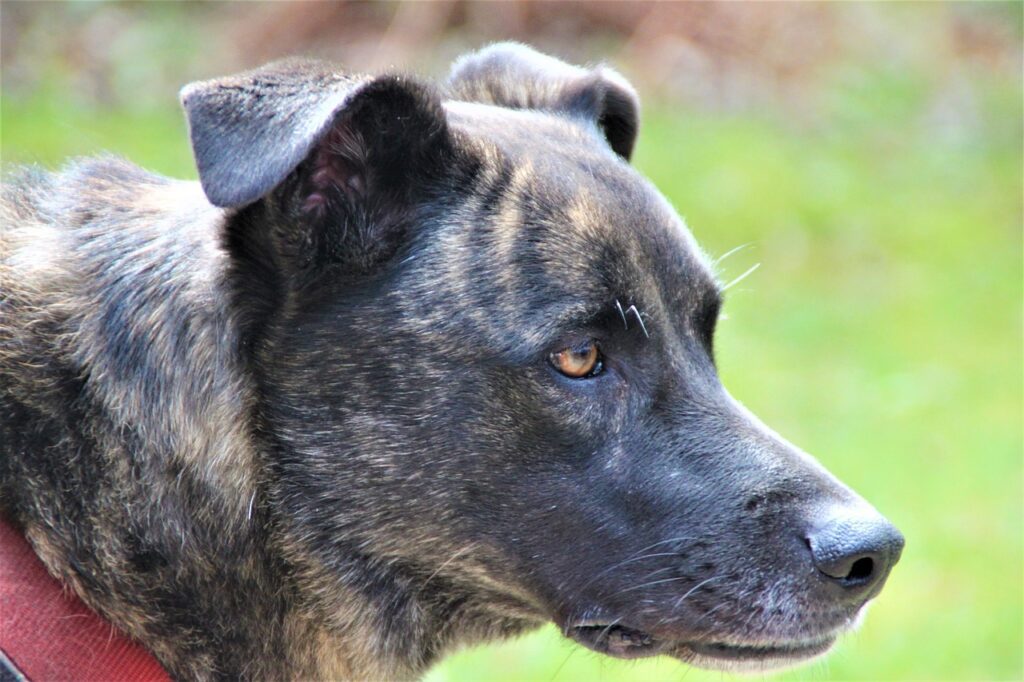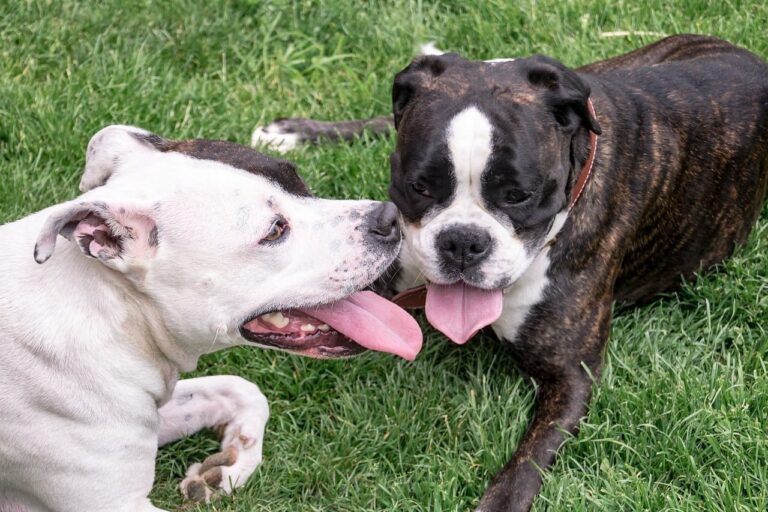Brindle dogs are those with a unique coat pattern that is characterized by a mixture of dark and light stripes or spots. This coat pattern can appear in various dog breeds, such as Boxers, Greyhounds, and French Bulldogs. However, some people believe that brindle dogs are more aggressive than other breeds, leading to unfair stereotypes and discrimination. Is there any truth to this claim, or is it just a myth?
The answer is that brindle dogs are not more aggressive than dogs of other colors. Aggressiveness is a behavior that is determined by many factors, such as genetics, environment, and training, not by coat color or pattern. Therefore, it is essential to provide proper socialization and training to any dog, regardless of its coat color. It is also important to note that brindle dogs may be less popular than other coat colors due to misconceptions about their temperament. This may result in fewer opportunities for adoption, fostering, and breeding, which can affect the welfare and diversity of brindle dogs.
The Beauty of Brindle Coat:
Let’s take a moment to acknowledge the distinct beauty of brindle canines before exploring the misconceptions. A coat pattern called brindle is characterized by colored patches or streaks over a darker base coat, giving it an alluring tiger-stripe appearance. It’s crucial to understand that a dog’s temperament or behavior are unaffected by the color of its coat. Dogs’ personalities vary, just like people’s do, therefore it’s important not to judge a dog just by how they look.
Why brindle dogs are more aggressive: The Myth
There is no truth to the myth that brindle dogs are more aggressive. Dog aggression is not related to the color or pattern of their coat; rather, it results from a combination of genetics, socialization, training, and environmental variables. Making judgments about a dog’s behavior based on how it looks is unfair and inaccurate.

Understanding Dog Aggression:
Any breed of dog, regardless of the color of their coat, is capable of exhibiting the complicated behavior known as aggression. Due to lack of proper socialization and training, fear, anxiety, and territorial tendencies can all cause dogs to become violent. Instead than blaming aggression on purely aesthetic considerations like coat color, responsible dog ownership requires identifying and resolving the underlying reasons of aggression.
The Role Of Genetics:
A dog’s genetics significantly influence its temperament and behavior. It is important to understand that coat color is not a decisive element, even though certain breeds may have particular characteristics. Simple genetic differences in the distribution of pigment lead to bristly coats. The behavior of a dog is significantly more influenced by responsible breeding practices and early socialization than by its coat color.
Brindle Breeds: Diversity of temperament
There are many dog breeds with brindle coat patterns, and each type has a distinctive temperament. Brindle dogs come in all different shapes and sizes, and they have a wide range of characteristics, from Boxers and Pit-bull to Greyhounds and Mastiffs. Generalizing about a whole breed solely on the color of their coat is not only false but also deceptive.
Socialization and Training is the key:
A dog’s early interactions and experiences with people, other animals, and its environment have a significant impact on how it acts. An adult dog who has received the proper socialization during a puppy’s crucial formative stage is more likely to be adaptable and friendly. In a similar vein, regardless of the color of a dog’s coat, prevention and management of aggressive behavior in all dogs require persistent and positive training methods.
Nature vs. Nurture: The Real Influences on Aggression
Dog aggression frequently results from a mix of nature and nurture. A dog’s temperament is influenced by genetics, but environmental variables and early experiences are also important. Regardless of the color of the dog’s coat, proper socialization, positive reinforcement training, and regular discipline are essential to cultivating a well-behaved and balanced canine.
The power of perception:
It’s possible that a bias in perception is to blame for the idea that brindle dogs are more aggressive. Similar to any stereotype, when it permeates society it can affect how people view and interpret a dog’s behavior based only on the color of their coat. In actuality, a brindle dog’s temperament varies depending on personal elements like genetics, early socialization, training, and surroundings.
Brindle Breed: A diverse Group
Numerous breeds of dogs have a coat pattern called brindle, and every breed has a different temperament and set of characteristics. For instance, the brindle coat pattern is frequently seen on the Boxer, a breed renowned for its friendly and playful disposition. Contrarily, the Greyhound, which also has a brindle coat, is renowned for having a calm and kind nature. That coat color is not a reliable predictor of a dog’s behavior is further emphasized by the variety in temperaments across brindle breeds.
Debunking the Pit-bull Myth:
Pit-bull frequently endure the most unjust stereotypes of any brindle breeds. Because of how they seem, they are typically singled out as hostile. Pit-bull can, however, become devoted, kind, and lovable pets if they are nurtured and taught properly. Pit-bull are not always violent; in fact, many of them make wonderful family pets.
Nurturing a Loving Brindle Companion:
Early socialization is essential if you want your brindle dog to mature into a loving and polite friend. During the puppy stage, exposing them to a variety of settings, humans, and other animals helps them gain self-assurance and learn acceptable social behaviors. Positive reinforcement training also fosters appropriate behavior and bolsters the relationship between the dog and its owner.
Debunking the myth: no scientific evidence
When examining any claim, including the notion that brindle dogs are more aggressive, it is crucial to depend on scientific data. This claim has not yet been supported by any reliable scientific research. No one coat color has been specifically related to increased levels of aggression among dog breeds because aggression is a complex behavior impacted by many different factors.
Recognizing Warning Signs:
Although brindle dogs don’t seem to be naturally violent, all dog owners need to be aware of the indications of stress, fear, or hostility. Growling, snarling, snapping, and biting are examples of these behaviors. If any of these actions are noticed, seeing a qualified dog trainer or behaviorists is essential to solving the problem effectively.
Seeing Professional Help For Aggression:
Seeking expert assistance from a licensed dog trainer or animal behaviorists is essential if you have a brindle dog or any dog exhibiting violent behavior. These professionals can identify the underlying factors causing the hostility and provide a customized training program to address the problem successfully. Always keep in mind that aggression is a behavioral issue that can be addressed and improved with the appropriate strategy.
Conclusion:
In conclusion, it is important to eliminate the erroneous misconception that brindle dogs are more aggressive. The behavior of brindle dogs is influenced by a number of variables, including genetics, socialization, training, and environment, much like the behavior of dogs with any other coat color or pattern. Let’s appreciate the diversity and individuality of brindle dogs as responsible dog owners and enthusiasts while dispelling myths that unfairly stigmatize them.
Keep in mind that a dog’s temperament is influenced by the love, attention, and training given by its owner. To create a joyful, healthy, and loving relationship between you and your furry friend, embrace the uniqueness of your brindle pet and concentrate on creating a supportive atmosphere.
- How to Start Feeding Your Dog Raw Food
- How to Teach an Old Dog to Use a Pee Pad Successfully
- Unlock Your Dog’s Superfood: 6 Essential Nutrients They Thrive On!
- Purina Pro Plan vs Blue Buffalo: Unveiling the Best for Your Pup
- Black Mouth Cur’s Choice: Premium Dog Food Guide


